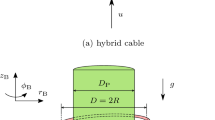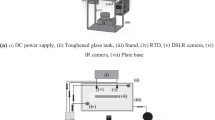Abstract
Infrared thermography has increasingly gained importance because of environmental and technological advancements of this method and is applied in a variety of disciplines related to non-isothermal flow. However, it has not been used so far for quantitative thermal analysis in saturated porous media. This article suggests infrared thermographic approach to obtain the entire surface temperature distribution(s) in water-saturated porous media. For this purpose, infrared thermal analysis is applied with in situ calibration for a better understanding of the heat transfer processes in porous media. Calibration is achieved with a combination of invasive sensors which are inserted into the medium and non-invasive thermal sensors in which sensors are not inserted to measure temperatures but it works through the detection of infrared radiation emitted from the surface. Thermocouples of relatively thin diameter are used to minimize the disturbance for flow. Thermocouples give the temperature values at specified positions inside the porous medium, and these values are compared with the values suggested by the infrared thermographic device at the same positions, in the calibration exercise. The calibration process was repeated for different temperatures and flow rates to get the temperature distributions of the whole material inside the system. This technique enables us to measure accurate two-dimensional temperature distributions, which is not possible by using thermocouples only. Continuous point heat sources at different flow rates and temperatures are studied experimentally. Additionally, it offers numerical simulations of the experiments utilizing a finite element-based model. A two-dimensional density and viscosity-dependent flow and transport model accounting for thermal dispersion is utilized to simulate the experimental results. Possible small heat losses from the surface are incorporated in the model according to the properties and thickness of the Plexiglass material used for the construction of the experiment tank. The numerical results agree well with the experimental observations.














Similar content being viewed by others
References
Abdullah N, Taalib ARA, Jaffar AA, Salleh MAM (2010) The basics and issues of thermochromic liquid crystal calibrations. Exp Thermal Fluid Sci 34(8):1089–1121
Astarita T, Cardone G, Carlomagno GM, Meola C (2000) A survey on infrared thermography for convective heat transfer measurements. Optics & Laser Technology 32:593–610. doi:10.1016/S0030-3992(00)00086-4
Bolf N (2004) Application of infrared thermography in chemical engineering. Kem Ind 53(12):549–555
Carlomagno GM, Cardone G (2010) Infrared thermography for convective heat transfer measurements. Experiemnts in Fluids 49(6):1187–1218
Fukukawa T, Ligrani PM (2002) Transonic film cooling effectiveness from shaped holes on a simulated turbine airfoil. J. Thermophysics and Heat Transfer 16(2):228–237
de Ghislain M (1986) Quantitative hydrogeology: groundwater hydrology for engineers. Academic Press, New York
Gritsch M, Schulz A, Wittig S (1998) Adiabatic wall effectiveness measurements of film cooling holes with expanded exits. J Turbomach 120(3):549–556
Ham PAS, Schotting RJ, Prommer H, Davis GB (2004) Effects of hydrodynamic dispersion on plume lengths for instantaneous bimolecular reactions. Adv in Water Resour 27(80):803–813
Hooman K, Gurgenci H (2008) Effects of temperature-dependent viscosity on forced convection inside a porous medium. Transp Porous Med 75(2):249–267
InfraTech GmbH Manual for IRBIS control (2005): Thermal image processing and control software for systems VARIOSCAN 302× universal und PC
Kaviany M (1995) Principles of heat transfer in porous media. New York, 2nd edition. Springer-Verlag, New York
Lu X, Ren T, Gong Y (2009) Experimental investigation of thermal dispersion in saturated soils with one-dimensional water flow. SSSAJ 73(6):1912–1920
Magnani FS, da Silva RNT (2007) Infrared thermography applied to the quantitative determination of spatial and thermophysical parameters of hidden included objects. Appl Therm Eng 27:2378–2384
Meola C, Carlomagno GM (2004) Recent advances in the use of infrared thermography. Meas Sci Technoo 15(9):R27. doi:10.1088/0957-0233/15/9/R01
Metzger T, Didierjean S, Maillet D (2004) Optimal experimental estimation of thermal dispersion coefficients in porous media. Int J Heat and Mass Transfer 47:3341–3351. doi:10.1016/j.ijheatmasstransfer.2004.02.024
Minkina W, Dudzik S (2009) Infrared thermography errors and uncertainty. First edition
Nield DA, Bejan A (1999) Convection in porous media, 2nd edn. Springer-Verlag, New York
Pinder GF, Gray WG (2008) Essentials of multiphase flow and transport in porous media, 1st edn. John Wiley and Sons, New Jersey
Rau GC, Andersen MS, and Acworth RI (2012) Experimental investigation of the thermal dispersivity term and its significance in the heat transport equation for flow in sediments. Water Resourses Research 48 (3) doi:10.1029/2011WR011038
Saeid S, Al-Khoury R, Nick HM, Barends F (2014) Experimental-numerical study of heat flow in deep low-enthalpy geothermal conditions. Renew Energy 62:716–730. doi:10.1016/j.renene.2013.08.037
Saeid S, Al-Khoury R, Nick HM, Hicks MA (2015) A prototype design model for deep low-enthalpy hydrothermal systems. Renew Energy 77:408–422. doi:10.1016/j.renene.2014.12.018.
Schulz A (2000) Infrared thermography as applied to film cooling of gas turbine components. Meas Sci Technol 11:948–956
Shahraeeni E (2009) Infrared imagery of evaporation, ITES Research Colloquia, Zurich, Switzerland (2009-10-19)
Shahraeeni E, Or D (2010) Thermo-evaporative fluxes from heterogeneous porous surfaces resolved by infrared thermography. Water Resour Res 46:W09511
Shahraeeni E, Or D (2011) Quantification of subsurface thermal regimes beneath evaporating porous surfaces. Int J Heat Mass Trasf 54:4193–4202
Somerton WH (1992) Thermal properties and temperature related behavior of rock/fluid systems. Elsevier Science Publisher, New York
Tropea C, Alexander LY, Foss JF (2007) Handbook of experimental fluid mechanics. Springer, Berlin Heidelberg
Won SY, Burgess NK, Pedicord S, Ligrani PM (2004) Spatially resolved surface heat transfer for parallel rib turbulators with 45 degree orientations including test surface conduction analysis. ASME Trans J Heat Transfer 126(2):193–201
Acknowledgments
We would like to gratefully acknowledge the Higher Education Commission (HEC) of Pakistan and the International Research Training Group NUPUS for their financial assistance. Dr.-Ing. Hans-Peter Koschitzky and Prof. Dr.-Ing. Rainer Helmig from University of Stuttgart Germany agratefully acknowledged for their cooperation in arranging the infrared camera for our experimental facility. We appreciate and acknowledge the technical support of Pieter Kleingeld and Randlph van Kasteren at Utrecht University.
Author information
Authors and Affiliations
Corresponding author
Rights and permissions
About this article
Cite this article
Imran, M., Nick, H.M. & Schotting, R.J. Application of infrared thermography for temperature distributions in fluid-saturated porous media. Arab J Geosci 9, 318 (2016). https://doi.org/10.1007/s12517-016-2353-6
Received:
Accepted:
Published:
DOI: https://doi.org/10.1007/s12517-016-2353-6




